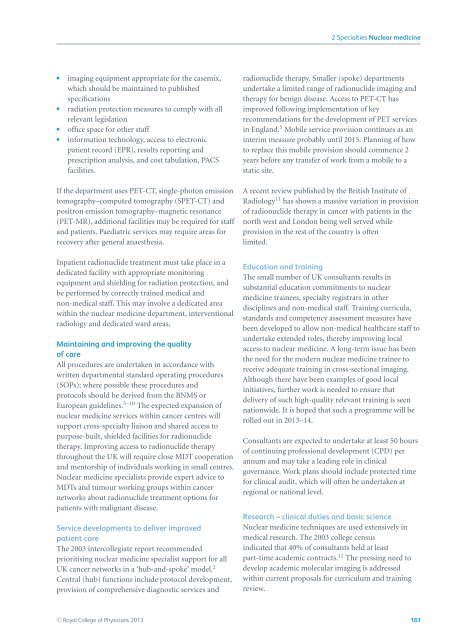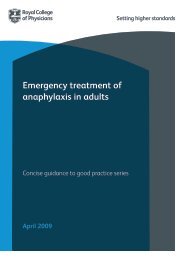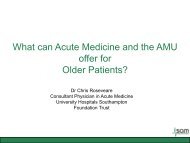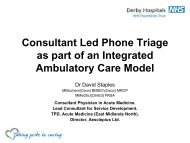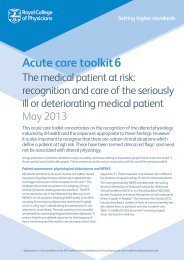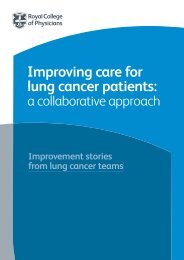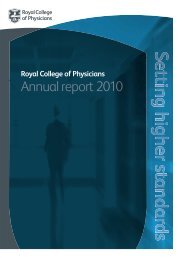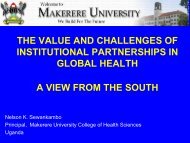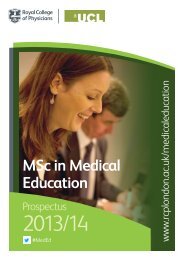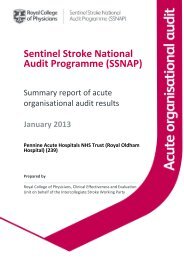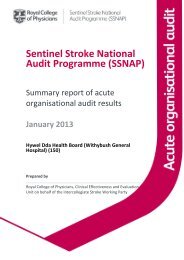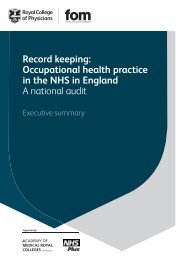Consultant physicians working with patients - Royal College of ...
Consultant physicians working with patients - Royal College of ...
Consultant physicians working with patients - Royal College of ...
Create successful ePaper yourself
Turn your PDF publications into a flip-book with our unique Google optimized e-Paper software.
2 Specialties Nuclear medicine imaging equipment appropriate for the casemix,which should be maintained to publishedspecifications radiation protection measures to comply <strong>with</strong> allrelevant legislation <strong>of</strong>fice space for other staff information technology, access to electronicpatient record (EPR), results reporting andprescription analysis, and cost tabulation, PACSfacilities.If the department uses PET-CT, single-photon emissiontomography–computed tomography (SPET-CT) andpositron emission tomography–magnetic resonance(PET-MR), additional facilities may be required for staffand <strong>patients</strong>. Paediatric services may require areas forrecovery after general anaesthesia.Inpatient radionuclide treatment must take place in adedicated facility <strong>with</strong> appropriate monitoringequipment and shielding for radiation protection, andbe performed by correctly trained medical andnon-medical staff. This may involve a dedicated area<strong>with</strong>in the nuclear medicine department, interventionalradiology and dedicated ward areas.Maintaining and improving the quality<strong>of</strong> careAll procedures are undertaken in accordance <strong>with</strong>written departmental standard operating procedures(SOPs); where possible these procedures andprotocols should be derived from the BNMS orEuropean guidelines. 3–10 The expected expansion <strong>of</strong>nuclear medicine services <strong>with</strong>in cancer centres willsupport cross-specialty liaison and shared access topurpose-built, shielded facilities for radionuclidetherapy. Improving access to radionuclide therapythroughout the UK will require close MDT cooperationand mentorship <strong>of</strong> individuals <strong>working</strong> in small centres.Nuclear medicine specialists provide expert advice toMDTs and tumour <strong>working</strong> groups <strong>with</strong>in cancernetworks about radionuclide treatment options for<strong>patients</strong> <strong>with</strong> malignant disease.Service developments to deliver improvedpatient careThe 2003 intercollegiate report recommendedprioritising nuclear medicine specialist support for allUK cancer networks in a ‘hub-and-spoke’ model. 2Central (hub) functions include protocol development,provision <strong>of</strong> comprehensive diagnostic services andradionuclide therapy. Smaller (spoke) departmentsundertake a limited range <strong>of</strong> radionuclide imaging andtherapy for benign disease. Access to PET-CT hasimproved following implementation <strong>of</strong> keyrecommendations for the development <strong>of</strong> PET servicesin England. 5 Mobile service provision continues as aninterim measure probably until 2015. Planning <strong>of</strong> howto replace this mobile provision should commence 2years before any transfer <strong>of</strong> work from a mobile to astatic site.A recent review published by the British Institute <strong>of</strong>Radiology 11 hasshownamassivevariationinprovision<strong>of</strong> radionuclide therapy in cancer <strong>with</strong> <strong>patients</strong> in thenorth west and London being well served whileprovision in the rest <strong>of</strong> the country is <strong>of</strong>tenlimited.Education and trainingThe small number <strong>of</strong> UK consultants results insubstantial education commitments to nuclearmedicine trainees, specialty registrars in otherdisciplines and non-medical staff. Training curricula,standards and competency assessment measures havebeen developed to allow non-medical healthcare staff toundertake extended roles, thereby improving localaccess to nuclear medicine. A long-term issue has beenthe need for the modern nuclear medicine trainee toreceive adequate training in cross-sectional imaging.Although there have been examples <strong>of</strong> good localinitiatives, further work is needed to ensure thatdelivery <strong>of</strong> such high-quality relevant training is seennationwide. It is hoped that such a programme will berolled out in 2013–14.<strong>Consultant</strong>s are expected to undertake at least 50 hours<strong>of</strong> continuing pr<strong>of</strong>essional development (CPD) perannum and may take a leading role in clinicalgovernance. Work plans should include protected timefor clinical audit, which will <strong>of</strong>ten be undertaken atregional or national level.Research – clinical duties and basic scienceNuclear medicine techniques are used extensively inmedical research. The 2003 college censusindicated that 40% <strong>of</strong> consultants held at leastpart-time academic contracts. 12 The pressing need todevelop academic molecular imaging is addressed<strong>with</strong>in current proposals for curriculum and trainingreview.C○ <strong>Royal</strong> <strong>College</strong> <strong>of</strong> Physicians 2013 183


